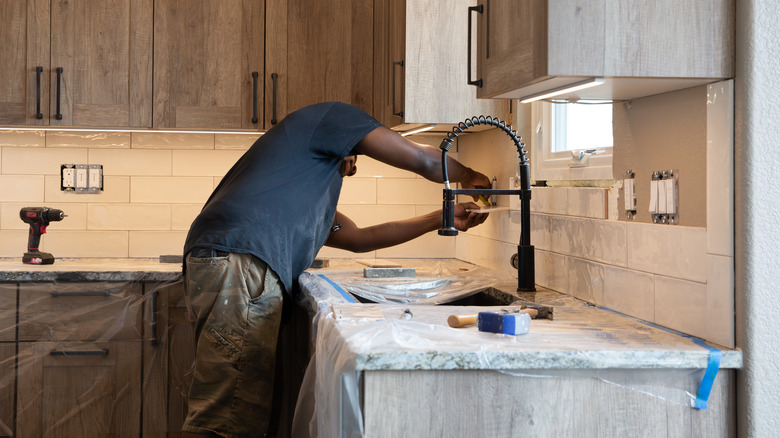The Unexpected Material You Can Use To Make An Intricate Kitchen Backsplash
We may receive a commission on purchases made from links.
Kitchen backsplashes have a purpose, and it's not particularly glamorous: They protect walls from splashes and stains. When something practical can serve both form and function, it's always more appealing, right? Legos have been stepping up as parts of 3D decor pieces that adults don't have to feel silly putting together. With this in mind, you can think of everyone's favorite plastic bricks as a part of a practical and pretty design. Pieced together like mosaic tiles, these interlocking bricks can step in as a creative backsplash idea in a kitchen or even in a transition space between a bathroom counter and mirror.
Innovative kitchen upgraders share designs on social media, from florals to abstracts, that are as easy to install as they are to take down. Even a classic mishmash of multicolored bricks is quintessentially Lego enough to inspire lots of smiles. This makes Lego backsplashes a delightfully clever renter-friendly upgrade that you can try without a lot of risk. Affix them to the wall with removable adhesive tabs, and seal the gaps with removable caulk like Dap Seal 'N Peel Removable Caulk for damage-free hanging.
Lego as a decorative medium can be costly, since there are hundreds of bricks involved in assembling a backsplash. However, finding your bricks at a thrift store or buying them used is one way to tackle this project at a manageable price point. Another important thing to consider is that Legos are not heat-safe, so mounting them behind a stovetop is a bad idea. Reserve this clever craft for locations that are a safe distance from any heat sources.
Build your own brick backsplash
The most practical aspect of a Lego backsplash is that, if done right, the surface is smooth and easy to clean. To do this, you'll be building several very tall sections that are the height of the space you want to fill. This way, the sides of the bricks are the surface that shows. Also, build your design sideways rather than from top to bottom. This will prevent long horizontal seams that make it too easy for the design to break apart.
Like you would for a colorwork knitting pattern, you can use graph paper to plot out your design; color in the squares where you'll be placing certain colored bricks to simplify the building process. You can gauge how many bricks you'll need for a space by first measuring it, then figuring how many Lego pieces fit together per inch. Account for any differences in width and height of the pieces, as well.
Work your pattern in smaller sections rather than one complete unit to make arranging the design on your wall manageable. Once you're ready to start piecing the sections together on the wall, prep the surfaces that will be wearing the adhesive. Clean the wall area (you may need to use a degreaser for those stubborn stains), and wipe the upside of the Lego sections with a cotton ball soaked in rubbing alcohol. This will help you get the most out of your adhesive. As you situate sections on the wall, press and hold them in place according to the directions on your adhesive tabs. A removable caulk seal around the design's borders can also help protect the edges from moisture while keeping this project renter-friendly.
